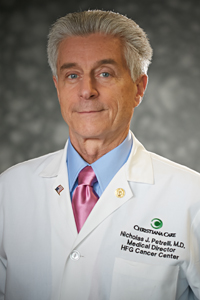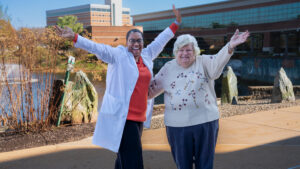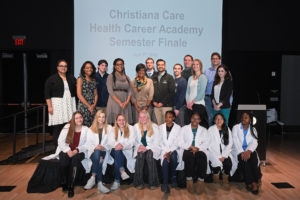Cancer specialists at the Helen F. Graham Cancer Center & Research Institute are closing the gap between classroom and real world with a pioneering clinical immersion program for biomedical engineering students, now in its fifth year.
The winter semester program is among the first of its kind to offer onsite experience in the operating room to future engineers who will develop the next generation of tools, devices and technologies that surgeons will use there. Piloted in 2013 in collaboration with the University of Delaware, the course challenges students to find solutions to unmet clinical needs.
“Our goal was to help the students understand our needs and limitations, and to train them to think clinically in an innovative way about solutions that could positively impact patient care, operating room flow and efficiency, and potentially reduce costs,” said surgical oncologist Joseph Bennett, M.D., section chief for Surgical Oncology, who directs the clinical immersion program at the Graham Cancer Center. “In just five weeks, the students came up with some very good ideas.”

“Over the years, this unique clinical immersion program has gained in popularity among the students, modeling success for similar cooperative learning experiences,” said Nicholas J. Petrelli, M.D., Bank of America endowed medical director of the Helen F. Graham Cancer Center. “What better way to encourage innovative, translational design ideas than to give biomedical engineering students the opportunity to experience the patient care environment first hand.”
This year, the Graham Center hosted 3 UD biomedical engineering students. They shadowed Dr. Bennett and other surgeons across a wide range of specialties and also spent time with the clinical engineering group.
Each student developed a poster project of their invention, which could potentially become a senior design project next year for the juniors in the group.
After shadowing Chief of Thoracic Surgery Charles Mulligan, M.D., biomedical engineering senior Andrew Dirks decided to develop an endoscopic rib shear for cardiothoracic procedures that necessitate clipping the ribs.
“The internship has been an incredible learning experience,” said Dirks. “An important lesson learned for designing medical devices is that you have to keep the end user — the surgeon, the patient, the hospital — in mind from the beginning.”
Senior Marissa Fichera worked with Dr. Bennett to design a learning tool to aid in proper placement of nasogastric tubes prior to surgery to improve patient safety and operating room efficiency. Fichera says she is now thinking about becoming a physician’s assistant after her experience at the Graham Cancer Center.
“The surgeons were always willing to teach and explain what they were doing while I was watching,” said Fichera. “There isn’t a thing I would change about the internship, except maybe to add a rotation with one of the Graham Cancer Center’s research scientists.”
UD Assistant Professor Jeannie Stephens, who is director of clinical and corporate relations for biomedical engineering, administers the program, secures student placements and also mentors them from an engineering perspective.
“The clinical immersion program provides UD biomedical engineering students the opportunity to gain exposure to the complexities of working in a clinical setting,” said Dr. Stephens. ‘The students work side-by-side with physicians to identify unmet clinical needs, and this exposure is crucial in the development of practical solutions that lead to improved patient care. Another outcome is the relationships that are formed between the students, the physicians and the faculty.”
Other Graham Cancer Center specialists who participated in this year’s course include gynecologic oncologist Mark Cadungog, M.D.; Director of Robotic Surgery Christopher Mitchell, M.D.; vascular surgeon Bhaskar Rao, M.D.; colorectal surgeon Shanthi Shakamuri, M.D.; and vascular and interventional radiologist George Kimbiris, M.D.
In addition to hosting new student interns again next year, Dr. Bennett hopes to sponsor a senior design project where the student would actually construct a prototype of his or her poster concept.


